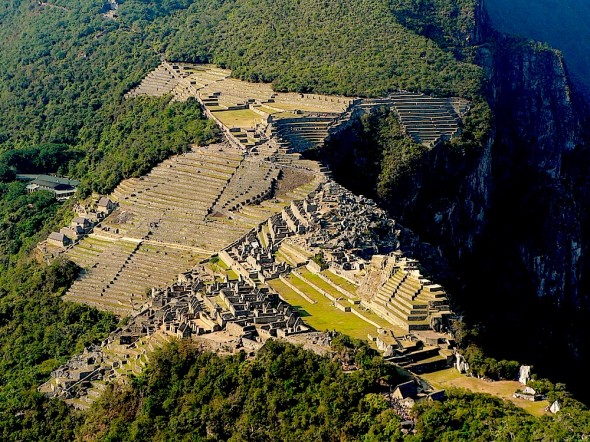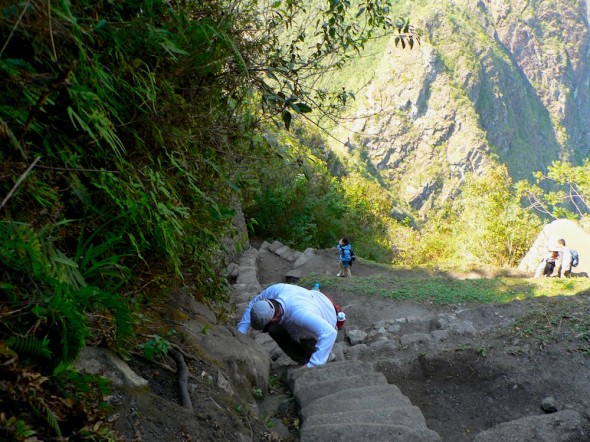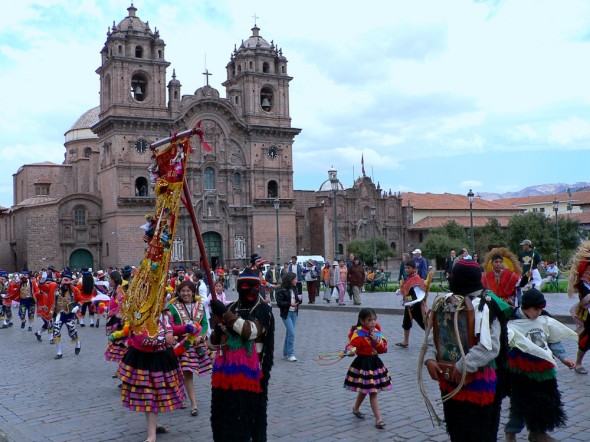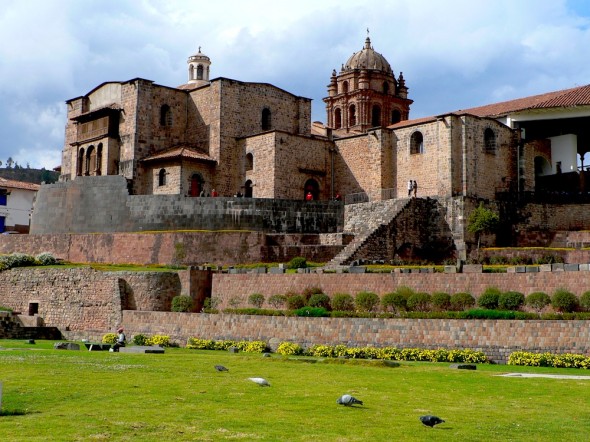
by Scott Ludlum
If you are headed for Machu Picchu prepare to be challenged by two peaks. The site was built on a narrow ridge between Machu Picchu (“old peak” in the local Quechua language) mountain and Huayna Picchu (“young peak”) mountain at an elevation of 8,000 feet. Part of the allure of visiting the Lost City of the Incas is the shear effort required just to arrive at the sacred ruins. Some take the famous Inca Trail, arriving after four days of strenuous trekking just in time for the dramatic sunrise from Intipunku, the Sun Gate. Others may take the high road, literally, hiking at altitudes as high as 15,200 feet and covering 35 miles over 6 days while “camping” in luxury inns along the way.
Yet even the “less adventurous” route to Machu Picchu entails taking a four-hour train trip from Cusco that is capped off with 30 minutes of death-defying bus travel up the mountain while negotiating numerous switchbacks with only inches separating the bus from plunging over the edge into the Urumbamba River 1,500 feet below.

The iconic journey to Machu Picchu
The iconic journey to Machu Picchu starts in Cusco where trekkers are advised to spend a couple of days acclimatizing to the high altitude before embarking on their adventure by foot to reach the sacred ruins four days later. Due to Peruvian Government regulations all hikers must join an organized group tour with licensed guides and porters who accompany them during the entire journey. Travelers visiting by way of train to Aguas Calientes simply need to have a day pass to enter the ruins.
While Cusco may be viewed by many as merely a necessary stopover en route to Machu Picchu, it’s a fascinating destination in itself with spectacular Incan masonry and unprecedented shopping opportunities. A guided tour is the best way to experience historic Cusco and the surrounding sights.

It all begins at the Plaza de Armas, which was once the epicenter of social life and religious celebration. Other highlights include gorgeous Cusco Cathedral, which dominates the plaza as a beautiful and significant monument; Qoricancha, meaning “Golden Courtyard” in Quechua and considered to be the most sacred site in the Inca religion; as well as the famous fortress, Sacsayhuaman, that was built with huge boulders adjoined with incredulous accuracy.

The first glimpse of Machu Picchu is one that will be etched in your memory for a lifetime. I recommend allotting at least two days to savor the experience in different ways. If there are no delays on the train ride from Cusco to Aguas Calientes, visitors generally have from late morning until closing time at sunset to explore the ruins. It’s best to arrange a guided tour so that a knowledgeable guide can explain in detail the cultural significance and interesting history of how Machu Picchu was formed and discovered. Travelers will learn that the Incas revered nature and worshipped Pacha Mama (Mother Earth) as evidenced by how the Temple of the Condor points in the direction of the sun; or how in the Temple of the Sun, the sun actually enters through one window during Summer Solstice and through another window during Winter Solstice; or how the Sacred Rock takes the shape of Yanantin Mountain that is directly behind it. If you look at the Sacred Rock carefully, you will notice that it is formed in the shape of a guinea pig, a local delicacy in Peru known as cuy.
For the adventurous, a trek to the famed peak of Huayna Picchu offers unprecedented opportunity to peer down at the ruins of Machu Picchu nearly 1,000 below. Huayna Picchu juts high up in the clouds behind the Citadel of Machu Picchu and should not be missed if you are in good health. The precipitously steep path up is helped with the support of cables anchored to the side of them mountain.
Once you negotiate your way down again, you can spend the rest of the day exploring the ruins on your own. Excess energy can be used for another trek 90 minutes up the actual Inca Trail to Intipunku, which is the Sun Gate. That is where Inca Trail Trekkers get their first glimpse of Machu Picchu before making their last push to the Lost City after a grueling three and a half day hike.
An added benefit of planning an adventure to Cusco and Machu Picchu is that it is easily combined in a customized itinerary that can include the Sacred Valley; the easily accessible southern Amazon Rainforest; and a visit to Puno, gateway to legendary Lake Titicaca — is the highest navigable lake in the world.
In addition to boasting more fascinating ruins and spectacular natural scenery, the Sacred Valley has added more upscale spa resorts in recent years so it offers weary travelers the opportunity to rest and relax while being surrounded by some of the most beautiful landscapes in the world.
The Manu Biosphere Reserve and the Tambopata National Reserve are two of the most isolated and pristine areas of the Amazon Jungle in Peru, as well as the best in all of South America.
The trip to Lake Titicaca from Cusco is an adventure in itself as the all-day bus or private land transfer crosses peaks at more than 15,000 feet, with a scheduled stop to see a glacier. At Lake Titicaca travelers can visit the Uros Floating Islands where indigenous communities reside on islands constructed out of tortora reeds.
A trip to Machu Picchu, popular as it is, is bucket list material as it is one of the world’s most memorable iconic journeys.
Scott Ludlum is the founder of Latin Adventure Tours and has lived and been traveling to Latin America for nearly 30 years. He can be reached by email at: [email protected].
Related Stories:

































































































































































































































































































Get Social